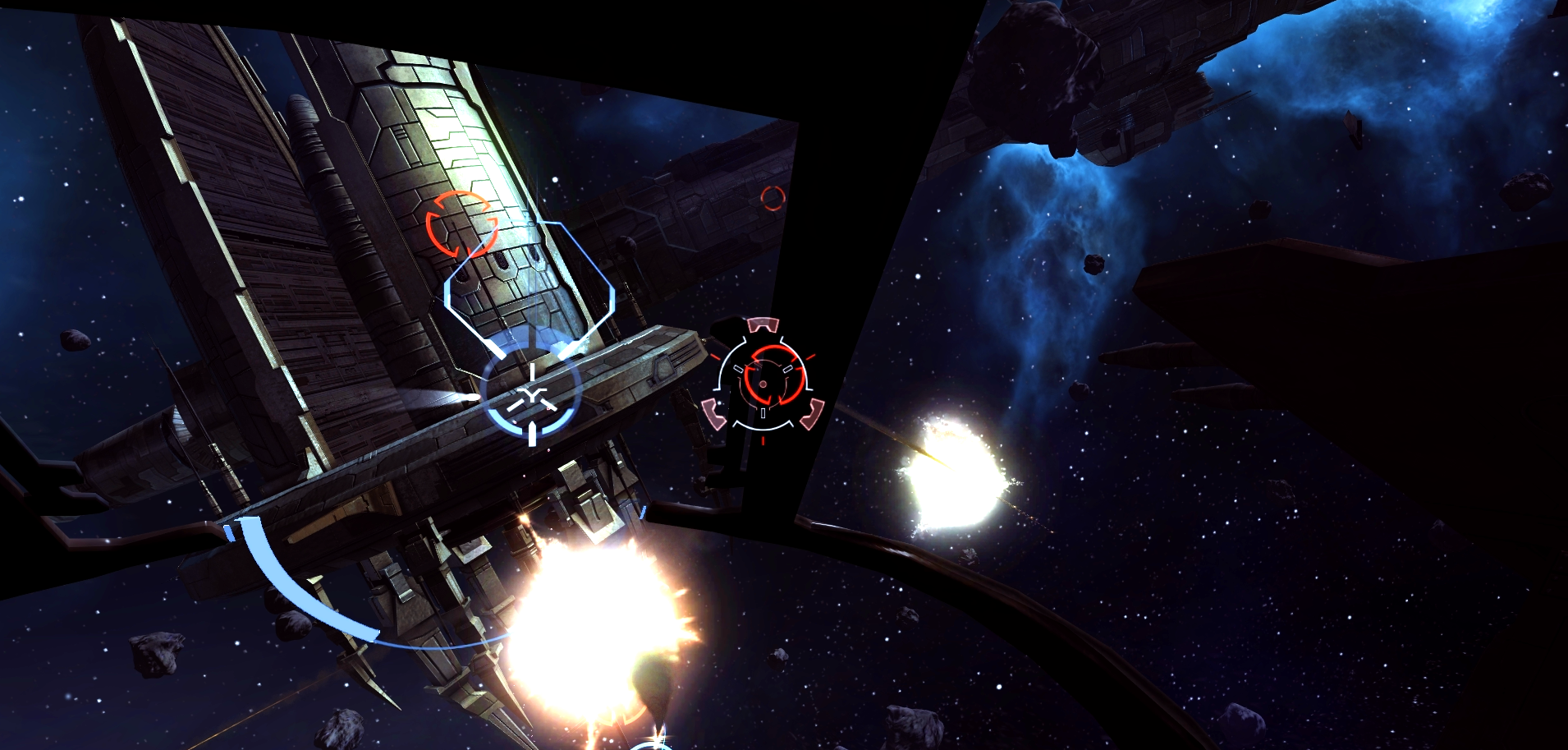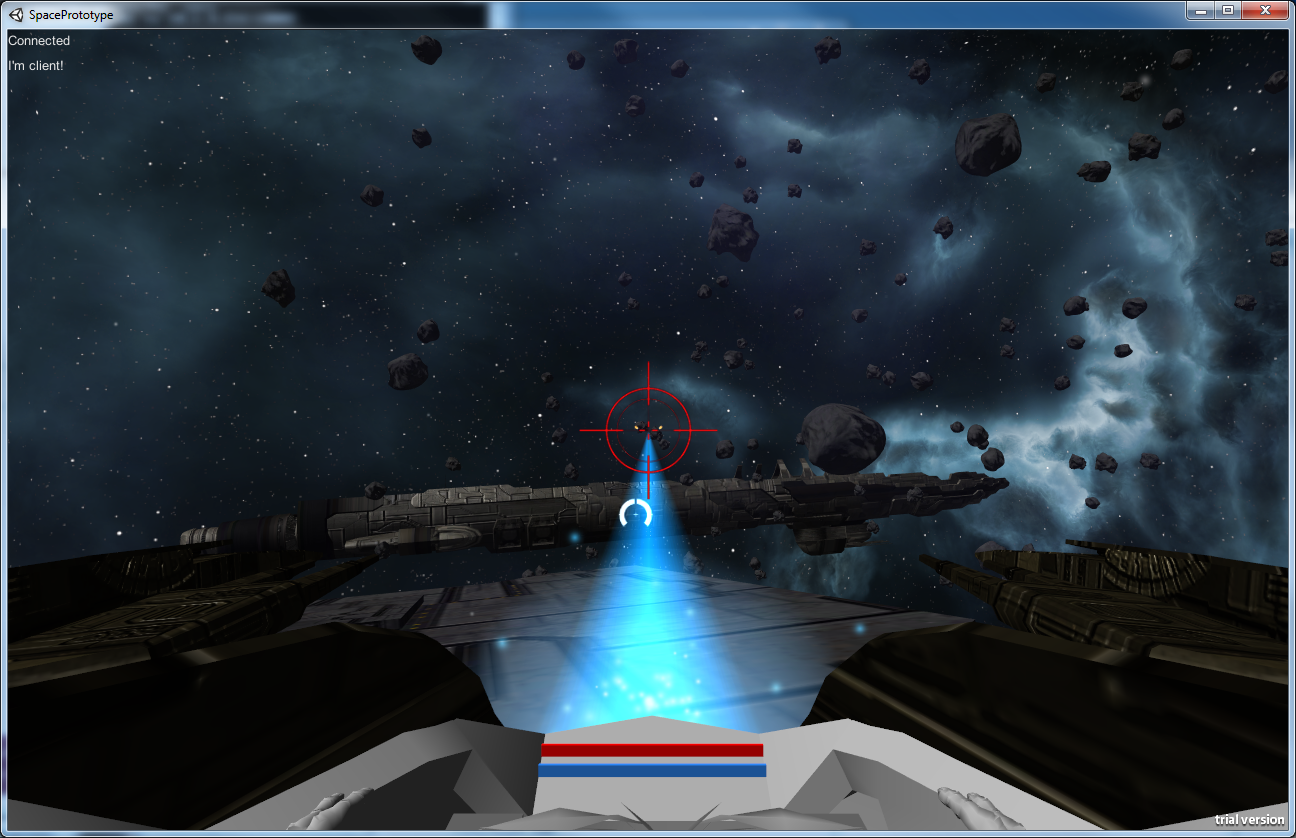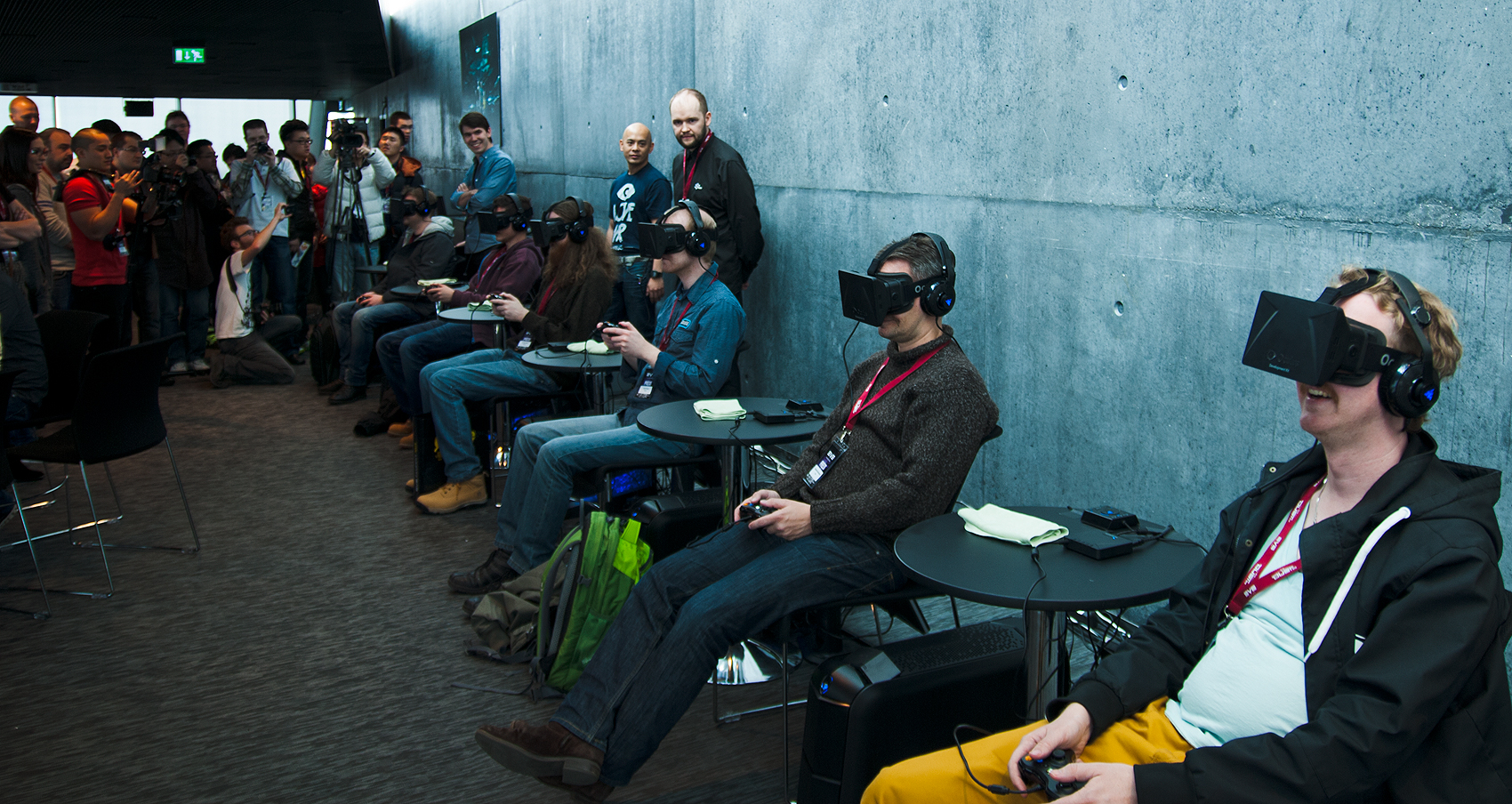EVE-VR: An experiment in bringing virtual reality to the EVE Universe
Greetings space fans,
We had something a little different to show off at this year's Fanfest: a fully functional virtual reality game prototype called EVE-VR! The game placed you in the cockpit of a fighter, engaging enemies in intense dogfights across the EVE Online® universe.
EVE-VR sparked a lot of interest from both players and the press, so we decided to write a devblog explaining how this idea came about, and what it was like developing a game for virtual reality.
Background
It all started in June 2012, with John Carmack showing off a crazy VR prototype at E3, and saying that virtual reality was coming back. Naturally, people were skeptical. But after reading everything he had to say and watching multiple interviews, I could tell by his enthusiasm that something was going on. Could this be it? Could we finally be seeing the dawn of the virtual reality we had been waiting for these last two decades? I certainly hoped so, and I was excited.
Keeping up with what Carmack was doing, I became aware of a tinkerer by the name of Palmer Luckey. When Palmer launched his company, Oculus VR, I immediately backed its Kickstarter campaign, and continued dreaming.
Soon after, I wanted to pull together a team to start experimenting with game design for VR, since the developer kits were supposed to ship by the end of the year. I work for a great company full of geeks, so inevitably my coworkers were interested in this technology as well, and I later learned that CCP actually backed the Kickstarter in a big way. I discovered that CCP Thoughtscape had also backed Palmer’s Kickstarter, and we began discussing what we could do with this new tech. From there, a group within CCP started forming as we were joined by people who had previous experience with Unity, and even a colleague who used to work for one of the VR giants back in "the (g)olden days." A lot of people helped us along the way, and for that we are very grateful.
Team EVE-VR from left to right: CCP Nimbus, CCP Lúxus Lúlli, CCP Lion, CCP TerrorShark, CCP Phor, CCP Masheen, CCP Thoughtscape, CCP BunnyVirus, CCP Karuck, CCP FoxFour, CCP WhiteNoiseTrash, CCP Konflikt.
We started meeting over beers and discussing what sorts of game ideas would be fun to make in VR, and what would work well. We brought up many genres and styles, but in the end decided to make a game in the EVE universe where players could fly fighter spaceships. That idea just checked all the boxes, and who hasn´t wanted to experience first-person space flight in EVE?
Initially things progressed slowly as ideas bounced around, but when we received our first two Rift developer kits at the end of February, we were as excited as kids opening Christmas presents! Back then, the only Rift experience was supplied by Oculus, who gave us an early version of the now-famous Tuscany demo. But we were blown away! Sure, the resolution was low, as expected, but we had prepared for more distortion, and the Rift was definitely delivering on the immersion factor.
Getting the kits really kicked EVE-VR development into high gear, and the game took shape at a very rapid pace. Every day we tested different ideas that were quickly prototyped and then working later the same day, which allowed us to quickly focus on a few core features.
Game design
Designing a game for virtual reality posed a lot of interesting challenges, and in many cases there weren't any known "best practices." We did a lot of trial-and-error to see what worked and what didn't. One of the early challenges was implementing UI in virtual reality. These elements are traditionally placed at the edge of the screen, but this does not work when you are constantly moving your head around and have a large field of view. Likewise, having static UI elements on the camera view won’t work, so almost all of the in-game UI is done with elements placed in the actual game world.
Additionally, the use of VR influenced design decisions such as weapon systems. Most gamers are accustomed to a fixed view, and we needed some way to “deprogram” that behavior and get them looking around the virtual world. The missile locking system was our answer to that. In order to lock on an enemy ship, you simply rotate your head to look at the target… then press the trigger and unleash hell!
Simulator sickness was a concern from the start. Based on our early tests and demos, people tended to get sick more easily playing games in which you stand and walk around. We found that sitting in a cockpit gives the brain a static frame of reference and the familiar sensation of sitting in a car.
Another factor which we found could often induce simulator sickness is acceleration. If the eyes are experiencing a change in velocity, but the body is not, it sends mixed signals to the brain which induces sickness. We counteracted this to some extent with both the large, open environment, and by keeping the forward speed of the ship relatively constant.
On the technical side, keeping a high frame-rate is extremely important and 60 Hz really is a minimum here. When you quickly turn your head, the number of pixels changing in a single frame is quite high, which translates to your brain as lag, and shatters the illusion of being in a virtual world.
A huge part of this project was creating an immersive experience and wrapping the EVE Universe around the player as a living, breathing fighter pilot. For the artists and sound designers, this meant rebuilding a familiar world from a different perspective. It was a unique way of approaching the workflow, switching the character’s body out for your own and focusing on the sensory information being fed through the hardware.
A perfect example of this was the audio soundscape that traditionally encompasses deep space from the comfort of your pod. For EVE-VR, we pulled this inwards for a more personal viewpoint with mechanically supplied oxygen and audible missile warnings, helping to build tension during gameplay. As soon as the headphones are on, the audio experience removes you from the real world, sits you firmly in the suffocating fighter cockpit, and is key to keeping you there.
The art also developed around the opportunities afforded by the Rift. Fighters were modeled from the ground up with a high level of detail, while the cockpits where retooled to look more tactile. Looking inward reveals a pilot surrounded by a dynamic range of flight systems that react to gameplay situations. Switching outward, the wings have visible bolts, scratches, and moving parts giving life and depth to the ship.
Determining the right visual scale was also key. During all this rapid prototyping, we established that having the pilot’s feet at roughly the same distance as your own helped ground the player in the virtual world. This allowed us to tweak camera values for greater range, eliminate a significant portion of the visual disconnection some users felt, and make subsequent decisions like condensing the launch tube. Moving from the hangar’s cramped conditions to the arena environment accentuated the feeling of wide open space laid out before you when you spill out of the carrier with your team.
Fanfest
When we started the project we were just a bunch of people excited about VR, but early on we got the idea of bringing our game to Fanfest to give other people the chance to experience it. This also fit well with the future-focused theme of this year’s Fanfest, marking the 10th anniversary of EVE Online.
After about 3 weeks of actual development, we contacted CCP Unifex and CCP Pokethulhu to give them a demo of our game, hoping for a green light to show it off at Fanfest. At that point we had a working multiplayer game in VR, where you sat in a cockpit and could shoot other players with two working weapons: a laser projectile and a charge-up laser beam!
We were quite worried about what they would think about the game, but really hoped we could have a small presence at Fanfest to give a few players the chance to experience the Oculus Rift. Our worries quickly disappeared: They were both blown away by the experience, to the point where it was difficult to get CCP Pokethulhu to take off the Rift! They immediately gave us the go-ahead to show the project off at Fanfest – but over the next few days it became apparent that we needed to scale this up for a bigger presence than we had originally planned.
From that point on, the development effort went a bit nuts and pretty much all of our evenings and weekends were spent working on EVE-VR. Everyone on the team worked really well together on scoping down ideas, setting milestones, and keeping us on-target for Fanfest.
We tried to prepare as well as we could with multiple internal playtests, including two events in the CCP dining hall where we invited the whole company to try the game, all of which helped us a lot in learning how to run things smoothly.
Fanfest came quickly, and it was hard to put away the keyboard and finalize the build with so many ideas left unfinished. Still, the entire team was very happy with how it turned out. Our first demo was a press event on Thursday, and since none of us had interacted with the press before, we were nervous. CCP Unifex did a quick introduction for us, and then let the press into a room we had prepared with six computers running EVE-VR.
Much to our relief, everyone loved the game and wanted to talk to us about it, and after all this hard work without being able to say a word, this was simply a fantastic experience for us all.
We were given great assistance at Fanfest by Nate Mitchell and Joseph Chen from Oculus VR. Their expertise and passion for the platform was invaluable and helped greatly in making the event a success.
On Friday, we had a few more meetings and interviews with the press. But our big moment came when CCP Hellmar revealed the game during the EVE keynote, and showed the trailer. Hearing the reaction from the crowd was just awesome and brought smiles to all our faces. I will always remember the moment when Hellmar said, "and you can all come try this out tomorrow..." and a guy in the crowd shouted an enthusiastic, "WHAT???"
Right after the keynote, we went downstairs to prepare the stage for Saturday, when all attendees would be given a chance to play our game. We worked late into the night and showed up super early, but it was all worth it when the doors opened at 10 AM and people ran for the queue. That line was full the whole day. We estimate that close to a thousand gamers played EVE-VR.
Since we had plenty of assistants, members of the team had a chance to talk to players after they’d tried the game. Those chats were our favorite part of Fanfest. People had loads of great ideas, and seeing smiles all around just made our day.
After our demo on Saturday we had the "CCP Presents" keynote where CCP Hellmar talked about the project and introduced Nate Mitchell from Oculus VR on stage.
Here is a clip showing our EVE-VR trailer and Nate speaking.
What's next?
We still don’t know what will become of this little project of ours, with CCP considering various options. However, I am sure that many people on the team will continue working on it in their spare time, and we hope to be able to release it in some form in the future.
I am also happy to announce that we will be showing EVE-VR off at E3 this year, but in a private meeting room. If you are a member of the press or someone that just HAS to see if for some reason, give us a shout and we'll see what we can arrange.
I only touched on a few subjects and didn't get too technical in this devblog, but I know members of the team are excited to discuss programming, art, audio, and design details with you! So please leave a comment or question on the forum discussion thread, and ask away!
New to EVE? Start your 14-day free trial today.
Returning pilot? Visit Account Management for the latest offers and promotions.







